Jan Lebenstein
Jan Lebenstein nació en Brest-Litovsk en 1930. Fue uno de los grandes pintores polacos de la segunda mitad del s.XX. Después de la guerra estudió pintura en la Academia de Bellas Artes de Varsovia, en el taller de Artur Nacht-Samborski [ver al final del post]. Desde mediados de la década de 1950, su Figura Axial (el auténtico emblema de su arte pictórico) fue cristalizando. En otoño de 1959, las Figuras Axiales fueron presentadas en la Primera Bienal de París, iniciada por el entonces Ministro de Cultura André Malraux. Lebenstein fue galardonado en la Bienal, y en 1961 una gran exhibición monográfica con sus trabajos se inauguró en el Museo de Arte Moderno de la Villa de París.
"Jardiner", óleo sobre lienzo / oil on canvas, 1965.
Bogdan Jakubowski collection, Paris. Foto / Photo: Piotr Ligier
"Czterej jeźdźcy Apokalipsy / Los cuatro jinetes del Apocalipsis /
The Four Horsemen of the Apocalypse", litografía a color sobre papel / color lithography on paper, 1985
Desde 1960 vivió permanentemente en París. Los '60, especialmente los primeros años de la década, fueron de un gran éxito internacional para el jóven pintor polaco. Sus pinturas se encontraban en las más prominentes exhibiciones europeas, colecciones privadas de Estados Unidos así como también en el Museum of Modern Art in New York. Por esa época, Lebenstein estableció estrechas relaciones de amistad con Konstanty A. Jeleński, Aleksander Wat, Mary McCarthy, Romain Gary, Jean Seber, y Jean Cassou.
"Straż przyboczna / Guardaespaldas / Bodyguard"
Litografía a color sobre papel / color lithography on paper, 48 x 68,5 cm., 1973
"Sentiments mixtes / Sentimientos mixtos / Mixed Feelings", óleo sobre lienzo / oil on canvas, 1967.
Colección privada / Private Collection. Foto / Photo: Piotr Ligier
"Apoteoza / Apoteosis / Apotheosis", tinta sobre papel / ink on paper, 20,3 x 13,4 cm.
El año 1968 fue un importante punto de inflexión, y sus consecuencias sociales y culturales condujeron al aislamiento del artista. En 1987 murió su amigo parisino más cercano, Konstanty A. Jeleński. En 1992 tuvo lugar una gran exposición monográfica de Jan Lebenstein en la Zachęta National Gallery of Arts, en Varsovia. Jan Lebenstein murió en Cracovia en 1999, cuando se presentó la exposición de sus trabajos "The Stages", en el International Cultural Centre.
Izq./ Left: "Figura osiowa / Figura axial / Axial Figure", pluma, tinta y acuarela sobre papel hecho a mano /
pen, ink and watercolor on handmade paper, 53,5 x 32 cm., 1963
Der./ Rigth: "Figura", técnica mixta sobre papel cuadriculado / mixed media on graph paper, 49 x 43,5 cm., 1960
"Figura osiowa / Figura Axial / Axial Figure", acuarela, tinta india y pluma sobre papel /
watercolor, indian ink and pen on paper, 34 x 49 cm., 1959
Se puede disfrutar de muchos más trabajos de este artista aquí (de donde traduje el apunte biográfico) y aquí.
"Sin título / Untitled", óleo sobre lienzo / oil on canvas, 1963
Bogdan Jakubowski collection, Paris. Foto / Photo: Piotr Ligier
"Dimanche au Soleil / Domingo al Sol / Sunday in the Sun"
Pluma y tinta sobre papel / pen and ink on paper, 43,5 x 53 cm., 1969
Jan Lebenstein, was born in Brest-Litovsk in 1930. He was one of the greatest Polish painters of the second half of 20th century. After the war, he studied painting at the Academy of Fine Arts in Warsaw, in the atelier of Artur Nacht-Samborski [see at the end of the post]. Since the mid-1950s, his Axial Figure – the very emblem of his painting art, had been crystallising. In autumn 1959, Axial Figures were presented on the 1st Biennale de Paris, initiated by the then Minister of Culture, André Malraux. Lebenstein was granted the main award of Biennale and in 1961 there was great monographic exhibition of his works opened at Musée d’Art moderne de la Ville de Paris.
"Ilustracja do 'Apokalipsy' / Ilustración de 'Apocalipsis' / Illustration form 'Apocalypse'"
Litografía color sobre papel / color lithography on paper, 50 x 30 cm., 1985
"Kąpiąca się i satyr / Baño y sátiro / Bath and Satyr"
Litografía color sobre papel / color lithograpy on paper, 43,5 x 33,9 cm.
"Les Siens", tinta, crayon y pastel sobre papel / ink, crayon and pastel on paper, 1969.
Bogdan Jakubowski collection, Paris. Foto / Photo: Piotr Ligier
Since 1960, he had been living in Paris permanently. The 1960s, and especially early years of the decade, were a great international success of the young Polish painter. His paintings were found at the most prominent European exhibitions, in private American collections as well as, inter alia, at the Museum of Modern Art in New York. During that time, Lebenstein built close friendships with Konstanty A. Jeleński, Aleksander Wat, Mary McCarthy, Romain Gary, Jean Seber, and Jean Cassou.
Izq./ Left: "Rysownik / Dibujante / Draftsman"
Litografía color sobre papel / color lithography on paper, 42,5 x 33,5 cm.
Der./ Right: "Portret z ptakiem / Retrato de un pájaro / Portrait of a Bird"
Litografía a color sobre papel / color lithography on paper, 32,7 x 22,8 cm.
"Z cyklu 'Folwark zwierzęcy' / De la serie 'Granja animal' / From 'Animal Farm' Series"
Litografía a color sobre papel / color lithography on paper, 50 x 70 cm., 1974
"Postacie fantasmagoryczne / Figuras fantasmagóricas / Ghostly Figures"
Pluma, tinta, acuarela, collage / pen, ink, watercolor and collage, 20 x 21 cm., 1962
The year 1968 was an important turning point, as its social and cultural consequences led to far isolation of the artist. On 1987, the closest Parisian friend of him, Konstanty A. Jeleński, died. In 1992, a great monographic exhibition of Jan Lebenstein took place at the Zachęta National Gallery of Arts in Warsaw. Jan Lebenstein died in Cracow in 1999, when exhibition of his works, The Stages, was presented at International Cultural Centre.
"Ministrele", acuarela, tinta, pluma, lápiz sobre papel / watercolor, ink, pen and pencil on paper, 34 x 23,5 cm.
You can enjoy a lot of works of this artist here (where I also took the biographic information) and here.
"Poids lourds I", 30 x 42,5 cm., 1966
Artur Nacht-Samborski
"Hojas en un jarrón blanco sobre una mesa / Leaves in a White Vase on a Table"
Óleo sobre lienzo / oil on canvas, 100 x 81 cm., c. 1970. Museo Nacional (Varsovia, Polonia / Warsaw, Poland)
Artur Nacht-Samborski fue un misterioso e inclasificable pintor polaco cuyo arte es difícil de describir y está por encima de los "ismos".
Estudió pintura entre 1918 y 1921 en la Academia de Bellas Artes de Cracovia. En su tiempo libre fue boxeador amateur.
Después de la guerra fue profesor en la Escuela de Artes Visuales de Gdansk (1947-49) y la Academia de Bellas Artes de Varsovia (1949-69), con un breve impasse entre 1950-52 cuando dominó el Realismo Social y Nacht-Samborski fue privado de su trabajo.
En el futuro le dedicaré más espacio.
Info in english here.




















No hay comentarios:
Publicar un comentario